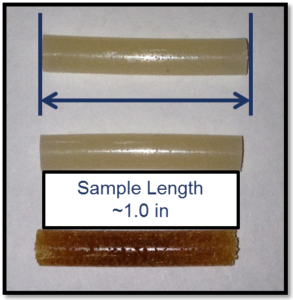Over the past 15 years, the Petersen Research Group at TAMU have refined techniques for laboratory-scale composite propellant manufacturing, with an emphasis on AP/HTPB formulations. The composite propellant samples are currently mixed in smaller batches on the order of 20 grams under a fume hood. The small batch size is convenient and produces manageable quantities for rapidly testing many formulations and techniques. Each ingredient is added individually starting with the liquids and then including the solids from smallest particle size to largest. After each ingredient is incorporated, the formulation is placed in a desiccator under vacuum to degas. The fume hood and vacuum system are shown in the image below. The final mixture is then extruded into Teflon tubing and cut to a final length of approximately 1 inch in length and weighing approximately 1 gram as shown in the figure below. The samples are then cured in an oven till completion. The final samples are stored in an explosives magazine as per the laboratory’s ATF license.

Propellant mixing area and equipment.

Photographs of various AP/HTPB samples with and without additives.
The average particle size and distribution of ammonium perchlorate are extremely important for the ballistics of the propellant mixture. As a result, every AP batch is sieved in a Resodyn Resonant Acoustic Mixer (RAM) using a series of sieves unless a specific AP size distribution is tested unmodified from the source providing it. AP particle size distributions are measured with a Beckman Coulter LS 13 320 XR Laser Diffraction Particle Size Analyzer available in the Mashuga laboratory at TAMU. Example AP particle distributions used recently at TAMU are shown below along with the LabRAM.

Example AP particle distributions created and particle sized at TAMU.

LabRAM with sieve attachment used to tailor AP particle size distributions.
In addition to solid composite propellants, the Petersen Research Group at TAMU also produces pellets similar to those used in air bag and other applications. These are commonly formulated from powdered fuel and oxidizer ingredients such as guanidine nitrate (GN) and basic copper nitrate (BCN). These pellets are prepared by first using the LabRAM which utilizes high-energy and low-frequency acoustic waves, creating a uniform shear force, for mixing powders, solids, liquids, gases, and mixtures thereof. After the pellet dry-powder ingredients are uniformly mixed, a press-and-die system is used to manufacture the propellant samples for burning.
A custom-machined pellet punch is filled with the dry propellant mixture (typically 3 grams). The pellet punch is then loaded into a Carver M-NE3890 hydraulic press to produce the solid propellant sample. The dimensions of the propellant sample are dictated by the study on hand, but the commonly used sample size at TAMU is 0.5 inches in diameter (12.5 mm) with a 0.5-in height. The sample is inhibited on its sides using an acrylic enamel spray (primer) and then loaded into a propellant sample holder. Ignition is typically via a nichrome wire but with the addition of a powdered igniter material that is placed atop of the cylindrical propellant sample. The image below shows typical pellet samples before and after inhibition along with the modified sample holder for burning.

Pressed-pellet propellant details. a) Typical 0.5-in sample of GN/BCN formulation; b) pellet with sides inhibited prior to testing; c) modified sample holder for pellets.
